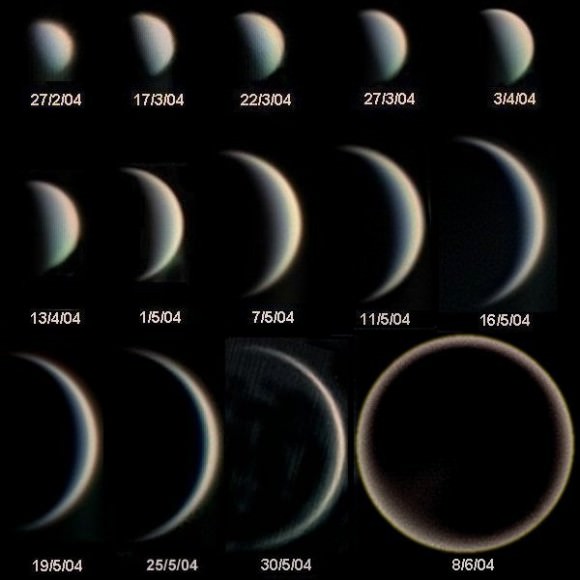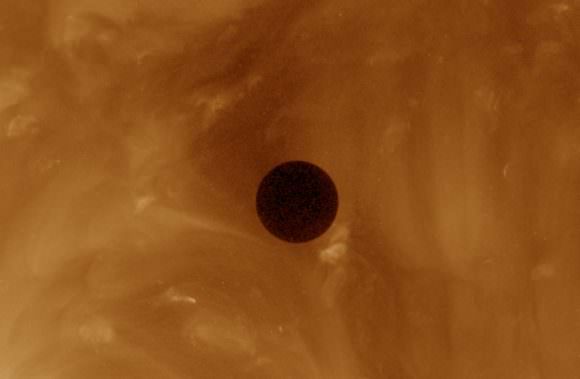Venus is often refereed to as “Earth’s sister planet”, thanks to the number of things it has in common with our planet. As a terrestrial planet, it is similarly composed of silicate rock and metals – which are differentiated between a metal core and a silicate crust and mantle. It also orbits within our Sun’s habitable zone, and had a similarly violent volcanic past.
But of course, there are also some major differences between our two planets. For one, Venus has an atmosphere that is incredibly dense (92 times that of Earth, in fact) and reaches temperatures that are hot enough to melt lead. In addition, the planet’s rotation is immensely slow by comparison, taking 243.025 days to complete a single rotation, and rotating backwards relative to Earth.
When discussing Venus’ rotation, it is important to note certain distinctions. Rotation is the time it takes for a planet to spin once on its axis. This is different from a planet’s revolution, which is the time it takes for a planet to orbit around another object (i.e. the Sun). So while it takes the Earth one day (24 hours) to rotate once on its axis, it takes one year (365.256 days) to revolve once around the Sun.

Orbital Period:
In Venus’ case, things work a little differently. For starters, it orbits the Sun at an average distance of about 0.72 AU (108,000,000 km; 67,000,000 mi) with almost no eccentricity. In fact, with its farthest orbit (aphelion) of 0.728 AU (108,939,000 km) and closest orbit (perihelion) of 0.718 AU (107,477,000 km), it has the most circular orbit of any planet in the Solar System.
The planet completes a revolution around the Sun every 224.65 Earth days, which means that a year on Venus last about 61.5% as long as a year on Earth. Evey 584 days, Venus completes an interior conjunction, where it lies between Earth and the Sun. It is at this point that Venus makes the closest approach to Earth of any planet, at an average distance of 41 million km.
Rotational Period:
Unlike most other planets in the Solar System, which rotate on their axes in an counter-clockwise direction, Venus rotates clockwise (called “retrograde” rotation). It also rotates very slowly, taking 243.025 Earth days to complete a single rotation. This is not only the slowest rotation period of any planet, it also means that a single day on Venus lasts longer than a Venusian year.

And, as noted earlier, Venus’ rotation is backwards, relative to Earth and the other bodies in the Solar System. Technically, this means that its rotational period is -243,025 days. It also means that if you could view the Solar System from the position above its celestial north pole, all of the planets (except for Uranus, which rotates on its side!) would appear to be rotating clockwise.
Venus, however, would appear to be rotating in a clockwise direction. Because of this, if you could stand on the surface of Venus, you would witness the Sun rising in the west and setting in the east. But you would be waiting a very long time to see this happen! Read on to find out why…
Sidereal vs. Solar Day:.
Another important thing to consider is the difference between a sidereal day and a solar day. A sidereal day corresponds to the amount of time it takes for a planet to rotate once on its axis, which in Venus’ case takes 243.025 Earth days. A solar day, by contrast, refers to the amount of time it takes for the Sun to reappear at the same point in the sky (i.e. between one sunrise/sunset and the next).
A Venusian (aka. Cytherean) Solar Day is the equivalent to 116.75 days on Earth, which means that it takes almost 117 days for the sun to rise, set, and return to the same place in the sky. Doing the math, we then see that a single year on Venus (224.65 Earth days) works out to just 1.92 Venusian (solar) days. Not exactly the basis for a good calendar system, is it?

Yes, when it comes to the planet Venus, things work quite differently than they do here on Earth. Not only does a day last over half a year on our “Sister Planet”, but the Sun rises and sets on the opposite horizons, and travels across the sky in the opposite direction. The reason for this, according to astronomers, is that billions of years ago (early in the planet’s history) Venus was impacted by another large planet.
The combined momentum between the two objects averaged out to the current rotational speed and direction, causing Venus to spin very slowly in its current retrograde motion. Someday, if human beings colonize there (perhaps in floating cities) they will have to learn to get used to a day that lasts over 2800 Earth hours, not to mention sunrises and sunsets happening on the wrong horizon!
We have written many interesting articles about Venus here at Universe Today. Here’s Interesting Facts About Venus, How Long is a Day on Venus?, How Long is a Year on Venus?, What is the Average Surface Temperature on Venus?, New Map Hints at Venus’ Wet, Volcanic Past and Venus Compared to Earth.
Want more information on Venus? Here’s a link to Hubblesite’s News Releases about Venus, and here’s a link to NASA’s Solar System Exploration Guide on Venus.
We have recorded a whole episode of Astronomy Cast that’s only about planet Venus. Listen to it here, Episode 50: Venus.


Uranus also has a “backwards” rotation
“And, as noted earlier, Venus’ rotation is backwards, relative to Earth and the other bodies in the Solar System. Technically, this means that its rotational period is -243,025 days. It also means that if you could view the Solar System from the position above its celestial north pole, all of the planets in would appear to be rotating counter-clockwise – except Venus, which rotates in a clockwise direction.”
Yes, I go along with the Uranus observation. Also, I think the article could do with some closer proof reading, particularly the last two major paragraphs where the language is somewhat obscure. But an interesting article nonetheless, I always find it hard to work out how the sun must appear in the skies of these planets. I take it it doesn’t rise and immediately set as it does on mercury, which I think is more to do with the orbital excentricity.
As for future human colonies, if it ever was possible and they were in floating cities, surely they could arrange to move through the atmosphere so that they would experience a more normal cycle of daylight.
-> Assuming the engineering/technology to facilitate the construction of such a city, my W.A.G. would be to stabilize the structure by making it at least somewhat aerodynamic, point it “nose” into the upper level winds, and then apply a small amount of thrust. This would have the end result of the colony “flying backwards” around the planet at a speed a bit slower than the upper level jets, which would (I’m speculating) speed up the day/night cycle of the inhabitants to around a week in length.
–> In the right places on Mercury one would see the sun rise, reverse course & “set,” then rise again before heading across the sky to set, then “rise,” then set again for good until the next diurnal cycle. Other locations would see the Sun rise, cross the local zenith, stop & reverse course back across the top of its arc, then stop again and resume its original path toward the horizon. All of this is thanks to the combined motion of Mercury’s speedy (& eccentric!) orbit and its slow prograde rotation (tidally synched to a 3:2 spin-orbit ratio).
Fact-based mental images which give birth to science fiction’s wildest dreams = why I love astronomy.
Venus does not have a ‘retrograde’ orbit. It rotates in the same direction as the other planets, so the stars will pass across its sky in the same direction. It just has a long day when compared to its year. On Earth, we have one less solar day than siderial day in a year because the sun does not stay fixed in our sky with respect to the stars; but this motion is slow compared to our planet’s rotation, so the sun only moves slowly with respect to the stars. Venus rotates slowly, so in its sky the sun goes the opposite direction to the stars.
It is a bit weird to call Uranus ‘retrograde’. I remember its rotational axis is whacked over at 98 degrees, so it is more ‘sideways’ than asything else.
Yes it does. Its rotational period is -243.025 days, which its rotation because it’s retrograde. And Uranus does rotate on its side, but it rotates clockwise, rather than counter-clockwise. So retrograde applies here too.
We used to be able to click on a pic and enlarge it so as to be able to read what is written there. In the pic “Earth and Venus’ orbit compared”, it won’t let me enlarge it to be able to read what it says. Why is that? This article and others would be more enjoyable if I could read the information provided.
Maybe a way to cool down Venus would be to direct some comets (water ice ones) into it and later, set a controllable screen to shade it from the sun, perhaps reducing the sun’s light hitting Venus by 95% until it cools down and after it does, allowing it to oscillate just to warm it up a bit over freezing water. One way to shade it would be to have some plants (somehow) floating on the upper atmosphere. And of course, it is a couple thousand year project to be fully implemented. Perhaps, by then we could spin it up a bit too.
Perhaps a ~70% effective solar shade with station-keeping ability, floating in the Sol-Venus L1 position (between the Sun & the planet)? Such a shade is probably an easier engineering feat than diverting all of those comets or building floating habitats, and certainly it could be done a lot more quickly… assuming any of it is doable at all, of course. 😀 I like where your head’s at though.
Thanks.
I read that almost all water on Venus is gone, thus, maybe the best way to wet it up would be to send some comets on it, even, if possible, slowing it down to avoid more heat. About the plants I was thinking about engineering some that would stay afloat by themselves, it would be more like seeding the clouds, perhaps a plant with taste for suffer gases.
http://www.esa.int/spaceinimages/Images/2008/03/The_eye_of_the_hurricane
Yet the south polar vortex seems to rotate every 44 hours. I find Venus very disturbing. Our closest neighbor would have to be so difficult.
Provocation! Perhaps in the future we will find out that it would be easier to re-engineer ourselves to survive those environments than change the environment.